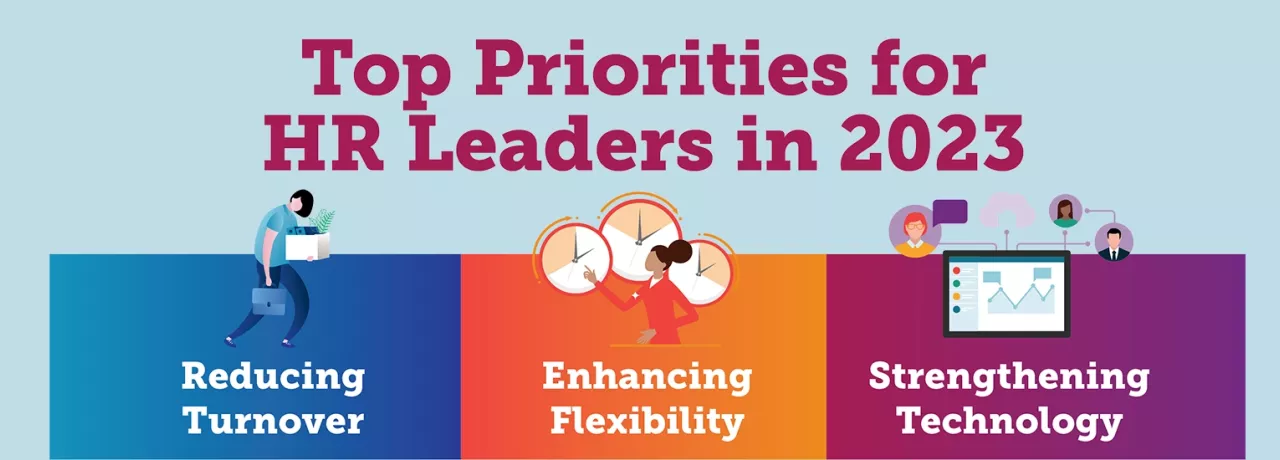
Top Priorities for HR Leaders in 2023
November 30, 2022
By Theresa Harkins-Schulz
HR leaders have been front and center in organizations over the past few years as companies have responded to major impacts related to the pandemic. Looking ahead to 2023, their role will continue to evolve as they work with organizational leaders to reduce turnover, enhance workplace flexibility, and strengthen the use of technology across the enterprise.
As 2022 winds down, here is what we see HR leaders focusing on now, and into 2023.
Reducing Turnover
Turnover is one of the top focus areas for organizations of all kinds and sizes. The workplace environment has been greatly impacted by trends like the “Great Resignation” and “Quiet Quitting.” HR leaders can reduce these impacts by:
- Creating a human-centric culture. Organizations have an opportunity to make the employee experience a memorable journey while focusing on opportunities to reduce fatigue, stress, and burnout. There’s a disconnect between employer and employee perceptions of the work experience — according to EY, 72% of employers believe workplace culture has improved since the pandemic — only 48% of employee respondents agree. Focusing on mental health and wellness should continue to be a priority moving into 2023. Don’t be afraid to ask employees how they’re doing and how the organization could better support their needs.
- Focusing on talent development. According to LinkedIn’s 2022 Learning Report, “opportunities to learn and grow is now the #1 factor that people say defines an exceptional work environment.” It’s the top driver of a good work culture. HR and L&D leaders have an opportunity to address employees’ development needs by upskilling, reskilling, increasing leader and manager effectiveness, and offering more career development opportunities.
- Acting quickly on employee feedback. While organizations often profess an interest in employee feedback and input, few put that interest into action beyond an annual survey or lip service to an “open door” policy. Even those that do, often have no mechanism in place to ensure that they can respond to that feedback effectively — or have empowered anyone to address the feedback and make the necessary changes to address employee needs! Today’s technology offers organizations the opportunity to collect employee input all along the employee journey, which can used to help evolve people strategy. This will help keep employees happy, feeling valued which increases employee engagement and improves retention. Giving the employee voice flexibility and freedom to be shared whenever they’re moved to do so — not just when they’re formally asked — can yield ongoing insights year-round. Don’t wait for the exit interview to gather feedback! Make it a real-time part of your employee engagement strategy.
Enhancing Flexibility
Many employees got a taste of enhanced flexibility during the pandemic and they’re not ready to let it go. Companies have an opportunity to be proactive in providing employees with the flexibility and work/life balance they crave to help boost recruitment, retention, engagement, and productivity by:
- Incorporating flexible work arrangements and schedules. According to a survey from EY, 90% of employees say they want flexibility — more than half say they’re ready to look elsewhere for employment if they don’t get it. That flexibility can, and should, vary by employee. Some may prefer a hybrid work arrangement — others an entirely remote arrangement where they can work from any geography. Some may appreciate time flexibility — a 7-3 schedule, for instance, to allow them to pick up kids from school or daycare. Others may value an opportunity for part-time work, or job share arrangements. Fortunately, employers today have a wide range of options available to provide employees with the flexibility they crave.
- Supporting managers who manage a remote workforce. Remote management has been a new experience for many managers and they’ve learned largely through trial and error. Moving forward, organizations have an opportunity to guide managers on how to be flexible and how to navigate the delicate balance between micromanaging people — getting into the nitty gritty of their work — and clearing the way for them to succeed by coaching from the sidelines. Adjusting work policies and benefits using a one-size-fits-all approach simply will not work. Individualized approaches are a must moving forward.
- Integrating different engagement drivers. Because employees’ needs are unique to them and they’re at different stages in their work and life journeys, different drivers must be used to engage them, and keep them engaged. For Gen Z this may mean helping them fulfill their purpose; for Boomers, it might mean helping them create a legacy for future generations. To maximize their employee engagement levels, organizations need to learn what drives their employees, and then use that intel to shape their employee experience into one that resonates with them.
Strengthening Technology
Technology changes and evolves with the times, as we have witnessed during the pandemic: organizations scrambled to find tech solutions that would ensure that employees remained connected with colleagues and customers wherever and whenever they needed to. Today’s technology drives both efficiency and engagement and fuels the ability of organizations to make better decisions. Organizations are strengthening their tech stack by:
- Increasing efficiencies and streamlining processes. Leveraging — and, in fact, embracing — the automation that comes with technology can help leaders free up their time to lead people, not processes. Tools like Inspirus Connects can be configured to automatically recognize a service anniversary or birthday, with managers getting notifications so they don’t miss any memorable moments. Technology can also reduce friction points to realize efficiencies across a wide range of processes and procedures. For instance, Connects Spotlights can feature companywide communication, so that enterprise messages come from a single source and don’t contain conflicting information.
- Connecting a disconnected workforce. This, of course, has been a big deal during the pandemic. And, as employees continue to demand the flexibility of remote and hybrid work, it will remain a big deal. Technology can be used to digitally connect and communicate to the masses uniformly and consistently. It can be used to create community, recognize peers and share vision and purpose — all of which can be done seamlessly through tools like Connects.
- Making data actionable to drive business decisions. The pandemic accelerated digital transformation and elevated the critical importance of using data to drive better business decisions. From a people perspective, data gleaned through employee feedback, surveys, and cultural assessments, can and should be used to improve company culture, and optimize business strategy. Leveraging that learning through the collection of data on an ongoing basis, can help organizations ensure employees feel connected, valued, and appreciated — and help fuel their business strategy.
As 2023 looms, organizations and their HR leaders have an opportunity to hit the ground running as they proactively address key focus areas that can impact employee engagement, productivity, and retention. If any of these are priorities for your organization in 2023, we invite you to reach out to talk to one of our specialists today




